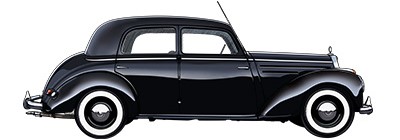Mercedes racing history for more than 125 years
For more than 125 years, the brand with the star has also shone in motorsport. During this time, many a car from Mercedes has raced across the finish line as a winner. Mercedes racing history began with the two-cylinder V-engine developed by Gottlieb Daimler and Wilhelm Maybach.
The first automobile competition in history took place in 1894 on a route from Paris to Rouen. Even here, the engines of the first-placed vehicles from Peugeot and Panhard-Levassor were based on designs by Maybach. Other victories of cars with Daimler engines such as the Gordon Bennett Cup in 1903, the Grand Prix in 1908 and 1914 followed. In particular, the period of supercharged cars after 1922 and the era of the Silver Arrows underpinned the reputation of cutting-edge technology from Germany.
Which was the first Mercedes racing car
The first racing car produced by Mercedes-Benz itself was the Daimler "Phoenix" with an engine power of 8 hp. It was built on behalf of Emil Jellinek. Just in time for the Nice racing weeks, three more Phoenix versions with 12 and 15 hp followed in March 1899. The characteristic feature of these cars was the circular tubular radiator that dominated the front face of the car. Two cars went to Arthur de Rothschild. One car was given to Jellinek, who appeared for the first time under the pseudonym "Monsieur Mercédès". All 3 Mercedes race cars drove to victory.
This was the starting signal of the Mercedes racing history. Over the next decades, cars from Mercedes-Benz participated in all the prestigious events in Europe and around the world. The cars won races, set records and broke new speed limits again and again.
An equally impressive example as the Phoenix was the so-called "Blitzen-Benz". With its 200 hp and the first combustion engine, it broke the magic mark of 200 km/h for the first time and held the absolute speed record of 228.1 km/h from 1911 to 1924.
Mercedes racing cars and the Silver Arrow era
Under the direction of racing director Alfred Neubauer, the Mercedes brand gained dominance on the Grand Prix circuits in the second half of the 1930s. Due to their distinctive shiny metal bodywork, Mercedes race cars of this era went down in motorsport history as the era of the Silver Arrows. With Rudolf Caracciola, by far the most successful racing driver of the time, Mercedes-Benz provided the European Grand Prix champion three times in 1935, 1937 and 1938.
Mercedes Race Cars with Victory Accents at a glance.
In addition to the Daimler Phoenix and the Silver Arrows, there were other impressive Mercedes Race Cars with victory accents in Mercedes racing history:
- Mercedes 300 SLR
Interrupted by the times of World War II, the Mercedes-Benz 300SLR followed the re-entry into international racing. He was considered one of the most beautiful racing cars that ever existed. Stirling Moss won the Mille Miglia with it in 1955. At an average of 150 km/h, it chased through the Italian roads for over 10 hours. But the 300 SLR was also part of the darkest chapter in Mercedes racing history. That same year, Pierre Levegh raced it into the crowd at the Le Mans race, killing 83 spectators. - Mercedes W196R
With the W 196R followed in 1954 and 55 two more world championship titles in Formula 1 history. Mercedes-Benz built two variants. The streamlined model, which was mainly used for fast race tracks such as Silverstone and Monza and the version with exposed wheels. - Mercedes AMG
After an interruption of more than 35 years, Mercedes-Benz first returned to Formula 1 as an engine supplier. In cooperation with McLaren Racing, this saw the return of Grand Prix victories with Mika Häkkinen in 1998 and 1999 and Lewis Hamilton in 2008. From the takeover of the Mercedes AMG F1 team in 2010, Mercedes-Benz again operated its own racing team. Lewis Hamilton rose with 6 more world championship titles to become the most successful driver in Formula 1 history. - Mercedes AMG C 63
In 2016, the Mercedes-Benz DTM team started with the AMG C 63 in the Formula 1 World Championship. Thus, you made life difficult for the immediate competitors of BMW and Audi. The Grand Prix season started in Melbourne, Australia, in March and ended in Abu Dabi in November. Nico Rosberg achieved his only Formula 1 victory there.
The Mercedes racing history in the sign of outstanding success
Over a century of motorsport under the sign of the star from Stuttgart. The interaction of innovative technology and talented racing drivers gave the Mercedes racing history outstanding successes.
Mercedes Racing is also inseparably linked to the history of automotive engineering. Many innovations in vehicle construction have their origins in motorsport. Automobile manufacturers quickly recognized the publicity-generating effect of racing and began to use it for their road vehicles as well. Technical developments and experience gained from motorsport go into series production, providing valuable impetus for improvements and progress in car and vehicle construction.




